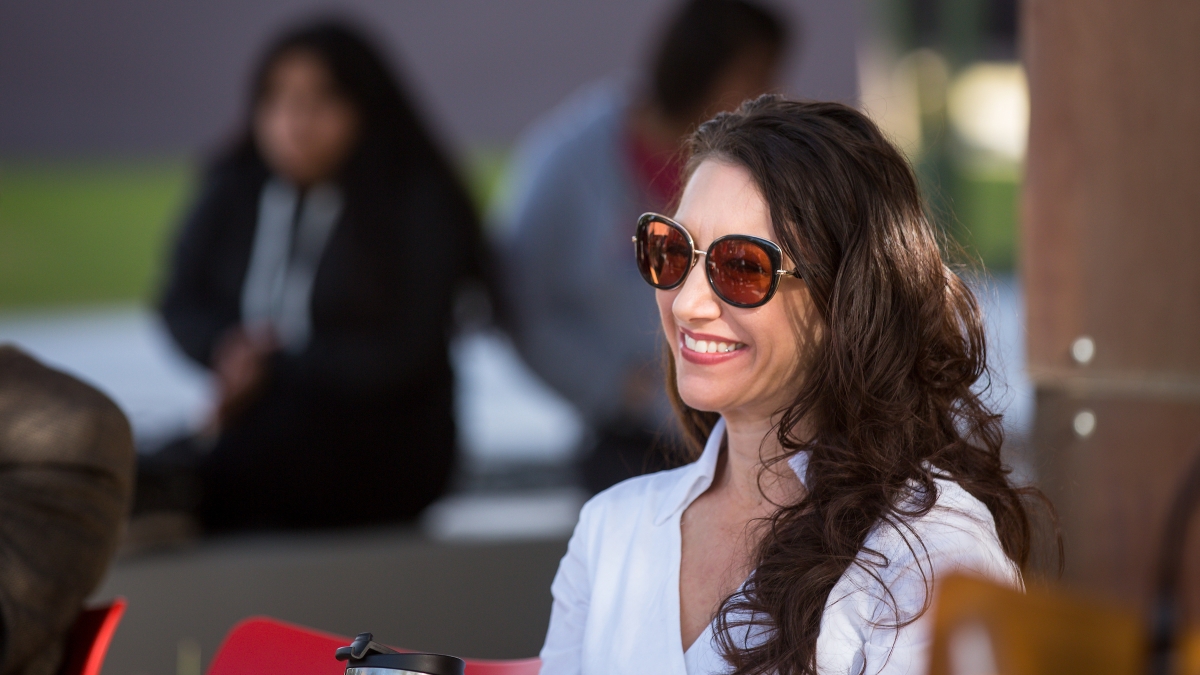About 1 in 68 children have autism and face difficulties that range from socialization and communication problems to restricted and repetitive behavior. At ASU, efforts to better understand and help those who live with the disorder include President's Professor James Adams’ autism research program, the Teachers College’s Curriculum and Instruction: Autism Spectrum Disorders degree and a recently formed student group, Autistics on Campus.
Still, it causes endless uncertainty — which ASU English lecturer Rosemarie DombrowskiDombrowski was recently named the City of Phoenix’s first poet laureate. understands as well as anyone. A poet, Dombrowski has chronicled ambiguity, shared joy and vented frustration as the mother of a nonverbal autistic son in the collection “The Book of Emergencies.”
In recognition of Autism Awareness Month, ASU Now sat down with Dombrowski to talk about her experience and gain insight into the sometimes-misunderstood disorder.
Question: What’s the meaning behind the name of your collection of poems?
Answer: When I began to parent — not just a child, but a child with autism, and in what I would consider to be the dark ages of autism awareness, because my son is 17 now — I felt like I needed a certain kind of handbook to handle the emergencies that came up on a daily, if not hourly, basis.
And no matter how many memoirs I read that were authored by mothers who had children with autism about the same age as my son, I never seemed to find the scenarios that I was looking for, or the ones that had applicable anecdotes.
So I think that’s sort of what the poems became for me — they became like a handbook for the uncertainty. And there certainly aren’t any answers there; it’s just a kind of an ethnographic handbook that allows a glimpse into the kinds of emergencies that arise as part of daily life.
Q: How did the collection come into being?
A: I had just started a reading series, and I had done a few feature readings around downtown 10-plus years ago. They were just the poems I had because that was the fodder that I had.
And then a couple years into that kind of rebuilding of the downtown poetry community process, I had a lot more of those poems … and people started asking me about them and started referring to them as a collection. And they weren’t really; in my mind, they were just the poems that I was writing.
But probably around that time, I started taking them and putting them together in a larger file that was entitled “The Book of Emergencies.” And at that point, it just kind of became my go-to space for processing and expression and some modicum of relief and healing.
Q: What was it like to become known for your poetry about autism?
A: Probably around 2011 or 2012 I just decided that I didn’t want those poems to define me anymore, that I had read them too much in the community, and I’d written too many of them.
I felt like I needed to be my own poet for a while, and not be “the autism poet.” It’s really easy to become the poet representing otherness or marginality, whatever that otherness or marginality is, and I think sometimes you just want to be a human being, and you just want to be your unique self with your unique perspective on the world in your poems. You want to talk about other things that are important to you.
And then when the opportunity for the book came up [in 2014], that was kind of when I started revisiting the pieces and thinking about how I might write a couple more from my 2014 perspective, which was really interesting. And now I’m working on an appendix to the book for a second edition, which I’m really excited about; I’m writing a section of poems that’s going to be called “Seventeen Letters, an Appendix to Emergencies.” I’m writing them all from my present-day perspective, and it’s literally seventeen epistolary poems to my son.
I still am working on other poems and other things but I think I’ve taken enough of a hiatus, and now I want to be back in the world of autism. I’ve spent a lot of time lately presenting about the medicalization of poetry, and I’ve been looking at it from a more academic perspective and seeing how important the autism poetry is to that conversation. I think I’ve become more of an advocate for medical poetry and disability poetry, or disability poetics, if you will, and the poetics of illness. … I’ve just realized the centrality of that to who I am as a poet and who I am as a scholar, and it’s OK to be the autism poet. So I definitely have embraced it more, and I’m excited to get back to it.
Q: Your son is nonverbal. Is that frustrating for you as someone who deals daily in language?
A: It certainly was in the early years. I really felt like we were the most mismatched mother-child pair that could have ever existed. Now I feel like we’re perfectly suited for one another. We go to concerts, we go to music festivals, we go to the beach, we go hiking together, we go for bike rides. He likes to do everything I like to do. Oh, and he loves antiquing. We get so much joy from the things that we do together.
He’s very exploratory, he likes looking at interesting things, he likes looking at interesting people. And then there are times when he just wants to sort of revel in a thing or a sound, and he can kind of shut the people out around him. Which is also how I am, as a poet. I’m good at, and I need to, in fact, shut out a lot of the people noise in order to get at the heart of the thing that I’m seeing, or the event, or the action. And he’s really, really good at that, and I love that about him.
Also he really responds to the language of music. He really responds to the language of movement, he responds to the language of sound, like the sound of objects. He flicks things and he taps things to hear their resonance and has different responses to them based on their pitch and their resonance and their register. That’s why he likes antiquing, because there’s so much interesting stuff and materials.
So I think, ultimately, the language thing, for me, doesn’t really feel like a barrier anymore. It’s taken me 15 or 16 years to get to this point, but I really love the way that he communicates. And I really value it. … I feel like our connection is deeper because we don’t have to use language to understand what we’re feeling about each other or a situation. For me, it’s just more special because it’s a kind of communication that I don’t have with anyone else.
Q: Do you have any advice for interacting with someone with autism?
A: Every person with autism is different. There’s a famous quote, “If you’ve met one person with autism, then you’ve met one person with autism.” There’s certainly not one way to interact with all of them. You really need to let the person with autism dictate how the interaction is going to go. … I think the most important thing is give them their space and let them dictate what they want from you and what they’re comfortable with. And then, if you’re comfortable, just follow suit.
Q: What’s one thing about autism you think everybody should know?
A: Brendan was at a gallery with me on Sunday and there was a little girl there and she wanted to hang out with Brendan, and they sat on these patio chairs across from each other and she just asked him questions for, I don’t know, 30 minutes. And he didn’t say anything, but he sat there across from her. And she was just relentless in her questioning, which was adorable.
The one thing that I would want people to know, because this is what I tell kids, is to not take it personally. … It’s not that he doesn’t want to be their friend, he just doesn’t go about it the same way that you do. And I think that advice is good for adults, too, when you’re interacting with anyone with autism, whether it’s a small child whose love you’re trying to engender, or affection you’re trying to engender, or it’s an adult with autism who you’re trying to forge a connection with. You just can’t take it personally because they just don’t operate on the same emotional register as we do. And they don’t operate on the same sort of social protocol register as we do. And that’s really, really important.
Top photo: ASU English lecturer Rosemarie Dombrowski at a December ceremony in which she was named the city of Phoenix's first poet laureate. Photo by Charlie Leight/ASU Now
More Health and medicine

First exchange student for Biodesign Institute Europe bridges labs 5,000 miles apart
This spring semester, Grace Colley traveled to Arizona State University and became the first student to participate in the Biodesign Institute Europe student exchange program. In doing so, she helped…

College of Health Solutions hosts visit from leading expert in genomic research
Some fortunate Arizona State University faculty, staff and students were able to gain valuable insights and perspective during a visit by one of the country’s leading figures in health and scientific…

Indigenous ASU research team recommends assistance for tribal members still reeling from COVID-19’s effects
When Matt Ignacio’s tribe, the Tohono O’odham Nation, donated $1 million to Arizona State University to support COVID-19 research, he applied for some of the money to understand and report any…
